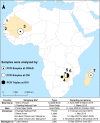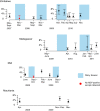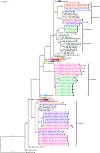Empirical analysis suggests continuous and homogeneous circulation of Newcastle disease virus in a wide range of wild bird species in Africa
- PMID: 25090191
- PMCID: PMC9507169
- DOI: 10.1017/S095026881400185X
Empirical analysis suggests continuous and homogeneous circulation of Newcastle disease virus in a wide range of wild bird species in Africa
Abstract
Newcastle disease (ND) is one of the most important poultry diseases worldwide and can lead to annual losses of up to 80% of backyard chickens in Africa. All bird species are considered susceptible to ND virus (NDV) infection but little is known about the role that wild birds play in the epidemiology of the virus. We present a long-term monitoring of 9000 wild birds in four African countries. Overall, 3·06% of the birds were PCR-positive for NDV infection, with prevalence ranging from 0% to 10% depending on the season, the site and the species considered. Our study shows that ND is circulating continuously and homogeneously in a large range of wild bird species. Several genotypes of NDV circulate concurrently in different species and are phylogenetically closely related to strains circulating in local domestic poultry, suggesting that wild birds may play several roles in the epidemiology of different NDV strains in Africa. We recommend that any strategic plan aiming at controlling ND in Africa should take into account the potential role of the local wild bird community in the transmission of the disease.
Keywords: Zimbabwe.
Conflict of interest statement
None.
Figures





References
-
- Alexander DJ, Aldous EW, Fuller CM. The long view: a selective review of 40 years of Newcastle disease research. Avian Pathology 2012; 41: 329–335. - PubMed
-
- Miller PJ, Decanini EL, Afonso CL. Newcastle disease: Evolution of genotypes and the related diagnostic challenges. Infection Genetics and Evolution 2010; 10: 26–35. - PubMed
-
- Piacenti AM, et al. Pathogenesis of Newcastle disease in commercial and specific pathogen-free turkeys experimentally infected with isolates of different virulence. Veterinary Pathology Online 2006; 43: 168–178. - PubMed
Publication types
MeSH terms
LinkOut - more resources
Full Text Sources
Other Literature Sources

